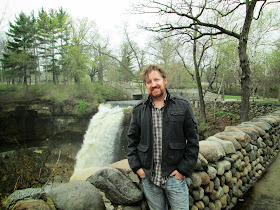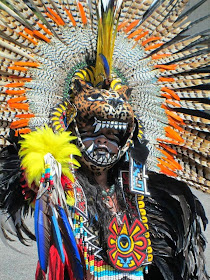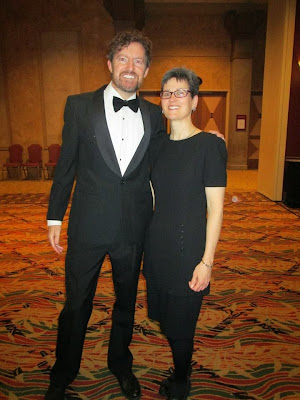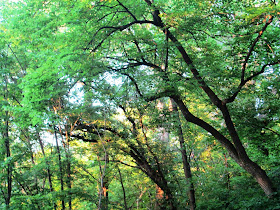The photo
above was taken in late April at Minnehaha Falls in south Minneapolis by my friend Brian. As you can see, there are emerging signs of spring all around me!
I was actually in Australia when the season began with the
spring equinox on March 20. Accordingly, it was the
autumnal equinox that I experienced in the "Great South Land."
Of course, early autumn in much of Australia is quite mild in terms of weather. How mild? Well, in Port Macquarie where I stayed with my parents for much of my time in Australia, I enjoyed a daily swim in the sea! Even more enjoyable was the time spent catching up with family and friends, not only in Port Macquarie but in Sydney, Gunnedah and Melbourne. I document my month-long visit to Australia in the following
Wild Reed posts:
• A Surprise for Raph . . . Well, Somewhat
• Return to Oz . . . Sydney to Be Exact!
• On Sacred Ground
• A Visit to Gunnedah
• Diamond Head
• A Visit to Melbourne, April 7-11, 2014
• Seascapes
• Port Macquarie Days
• Photo of the Day – April 17, 2014
• Last Days in Australia, April 15-18, 2014
Above: My home in south Minneapolis, where I've lived since
January 2012. I share this house with my good friend Tim (
right), who is absolutely the best housemate anyone could possibly want! He's just an all-round great guy.
I returned to Minnesota from my visit to Australia on April 17, Holy Thursday. (For
The Wild Reed's 2014 Holy Week series,
click here.)
When I had left a month earlier, there was still snow on the ground. Upon my return there was just one small patch in the back yard, which melted away within a few days. It had been such a
long hard winter that I'm sure everyone was relieved when it was finally vanquished!
Above: Spring returns to Minnesota!
Above and below: With my good friends Curtis and Liana and their beautiful daughter Amelia. . . . Oh, and Eddie "the Wonder Dog," of course!
You may remember that I had the honor of officiating at Curtis and Liana's wedding
last summer.
Above: A lovely photo of my dear friend Noelle with her granddaughter Amelia.
Left: Tim with Amelia – April 2014.
Above: My friends Joey and Kathleen at Joey's senior recital for the Northern Lights School for Violin – Sunday, April 27, 2014. Joey played Kreisler's Praeludium and Allegro.
Last spring I traveled with Kathleen, Joey, and another friend, Will, to Pahá Sápa (the Black Hills of South Dakota). It was a truly
memorable experience.
Above: Theologian and author Paul Lakeland speaking at St. Frances Cabrini Catholic Church on April 30, 2014.
To read the article I wrote about Lakeland's presentation on "Pope Francis and the Liberation of the Laity,"
click here.
Above: A participant in the 40th annual In the Heart of the Beast Puppet and Mask Theatre's Mayday parade.
For more images and commentary,
click here and
here.
On the evening of Friday, May 2, 2014, I attended with my good friend Kathleen (
left) the annual Sisters of St. Joseph of Carondelet Ministries Foundation Gala. This year, the gala raised over $120,000 for the foundation's much needed work of providing free health care to the uninsured at their fourteen St. Mary's Healthcare clinics throughout the Twin Cities area.
In the photo
above I'm pictured with my dear friends
Rita McDonald, CSJ; Kathleen McDonald, CSJ,
Brigid McDonald, CSJ; and Kathleen Olsen.
Above: With my friend Tom, who designed and maintains the Catholics for Marriage Equality MN (C4ME-MN)
website.
Right: Kathleen with our mutual friends Tom and Darlene White.
You may recall that Tom and Darlene feature in the C4ME-MN produced DVD
Catholics for Marriage Equality.
Speaking of marriage equality, this spring marked the first anniversary of Governor Mark Dayton's signing into law the bill that allows marriage equality for same-sex couples in Minnesota. To mark this special anniversary I posted at
The Wild Reed a
celebratory look back at the role Minnesota Catholics played in helping secure marriage equality in the civil sphere for same-sex couples.
Left: With some of the folks from a local Catholic parish who comprised the first group of participants in "Companions on a Sacred Journey," the workshop I've designed on evolutionary spirituality – May 7, 2014.
Here's how I describe the
workshop over at
The Progressive Catholic Voice:
Companions on a Sacred Journey is an interactive workshop that provides an opportunity to learn about, reflect upon, and respond to an expression of spirituality known as “evolutionary Christianity.”
As understood and expressed by Catholic theologians, scientists, and mystics such as Pierre Teilhard de Chardin, Beatrice Bruteau, Brian Swimme, Ilia Delio, Diarmuid Ó Murchú, Thomas Berry, and Gail Worcelo, evolutionary Christianity is a meaningful way of thinking and talking about God in our lives, our church, and our world; a way of hope that addresses the important issues of our day by welcoming and honoring both the findings of science and the enduring spiritual wisdom of our Catholic tradition, especially its mystical tradition.
Companions on a Sacred Journey is a program that can be readily tailored to the needs of specific groups. For example, it can be presented as a two-hour workshop, an all-day retreat, or a series of four one-hour presentations. The program is facilitated by Michael Bayly.
Michael has a Masters in Theology from St. Catherine’s University and a Masters in Theology and the Arts from United Theological Seminary. He is the author of Creating Safe Environments for LGBT Students: A Catholic Schools Perspective and the editor of the online forum, The Progressive Catholic Voice. Since 2003 he has served as the Executive Coordinator of the Twin Cities-based Catholic Pastoral Committee on Sexual Minorities (CPCSM), which is a founding member organization of the Catholic Coalition for Church Reform (CCCR).
For more on evolutionary spirituality, see the following
Wild Reed posts:
• In the Garden of Spirituality – Ilia Delio
• In the Garden of Spirituality – Diarmuid Ó Murchú
• Make Us Lovers, God of Love
• Out and About – Autumn 2013
• Threshold Musings
• The Sufi Way
Above: On Sunday, May 11, 2014, I participated in a Mother’s Day march and rally in solidarity with the
mothers of Chibok, Nigeria.
For more images and commentary,
click here.
Above: My friends Bob and John (with Emmet) – May 2014.
My friend Bob is a priest in the Old Catholic tradition . . . and the author of
the book on Old Catholicism. He married his longtime partner John
last summer before being deployed to Kuwait for eight months as a U.S. Army chaplain. In many ways, Bob and John's journey exemplifies the incredible gains that have been made for LGBT people in the U.S. within a remarkably short period of time. I couldn't be happier for them!
Above: Standing at left with my friends Rick, John, Bob (holding Emmet), and Brian – May 18, 2014.
Above: John and Bob relaxing at my home by Minnehaha Creek and its beautiful parkway (
below).
Above: Enjoying an outdoor dinner at the always welcoming home of my friends John and Noelle. Pictured (from left): Raul, Madeleine (holding Amelia), Noelle, John, Tim, Curtis, Liana, and Fred.
Left: Among the blossoming trees of Minnehaha Parkway.
 Above:
Above: The view of Lake Calhoun in Minneapolis from the roof of my friend Raul's apartment complex.
Above: Sharing a meal with my friends George, Ian, and Joan.
Last summer Joan and I enjoyed a relaxing long weekend on the beautiful Bayfield Peninsula in Wisconsin. For images and commentary,
click here.
Above: A night out with my friend Mike.
Above: With Kathleen (left), celebrating the birthday of our friend Mary.
Left: Friends Tim and Angela.
Above: In May, Tim and I hosted a "Welcome Back to Minnesota" party for our friend Angela. She had recently returned to Minnesota after a year in Texas.
Right: Standing beneath my photograph entitled "The Kiss," which was the recipient of the People's Choice Award at the June 13 opening of the Twin Cities Pride Art Exhibition at the Aloft Hotel in Minneapolis.
For more images and commentary,
click here.
Above, left and below: On the last day of spring, June 20, 2014, Tim and I went walking along Minnehaha Creek. Due to recent record-breaking rainfall, the creek has overflowed its banks in many places.
For more images and commentary on Minnehaha Creek in flood,
click here.
Above: The sky above our neighborhood on the eve of the
summer solstice, June 20, 2014.
See also the previous Wild Reed posts:
Out and About – Winter 2013-2014
Christmastide Approaches
Out and About – Autumn 2013
Out and About – Summer 2013
Out and About – Spring 2013



















































